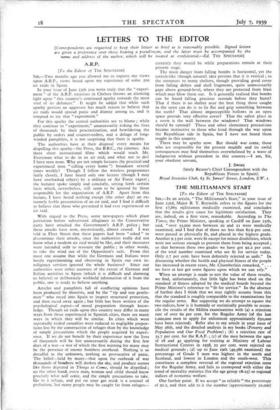THE MILITIAMAN'S START
[To the Editor of THE SPECTATOR] Stu,—In an article, " The Militiaman's Start," in your issue of June 23rd, Major B. T. Reynolds refers to the figures for the first 17,865 militiamen medically examined, and concludes that the results give cause for legitimate satisfaction. They are, indeed, on a first view, remarkable. According to The Times, the Prime Minister, speaking at Cardiff on June 25th, said, " over 55,000 men between 20 and 21 were medically examined, and I find that of those no less than 82.9 per cent. were passed as physically fit, and placed in the highest grade. Another 9.3 per cent. were fit except for minor disabilities, which were not serious enough to prevent them from being accepted ; so that between these two grades we have got 92.2 per cent. of the total number examined who are fit for service today. Only 2.7 per cent. have been definitely rejected as unfit." In discussing whether the health and physical fitness of the people has increased in recent years, Mr. Chamberlain remarked, " . . . we have at last got some figures upon which we can rely."
When an attempt is made to test the value of these results, we find, unfortunately, that little light has been shed on the standard of fitness adopted by the medical boards beyond the Prime Minister's reference to "fit for service." In the absence of further data I think that we may rightly assume from this that the standard is roughly comparable to the examinations for the regular army. But supposing we do attempt to equate the two indices, how is it humanly or statistically possible to recon- cile the results of the Militia examinations with (a) a rejection rate of over 6o per cent. for the Regular Army (of the last i,000,000 men to apply for enlistment approximately 65o,000 have been rejected). Refer also to my article in your issue of May 26th, and the detailed analysis in my books (Poverty and Population and Our Food Problem); (b) a rejection rate of 35.7 per cent. for the R.A.F. ; (c) of the men between the ages of 18 and 45 applying for training at Ministry of Labour Instructional Centres in 1938, 22 per cent. were rejected on medical grounds ; (d) up to June 19th (49,586 examined) the percentage of Grade I men was highest in the north and Scotland, and lowest in London and the south-west. This, constitutes a complete reversal of the regional rejection rates for the Regular Army, and fails to correspond with either the trend of mortality statistics (for the age group 18-25) or regional indices of economic welfare.
One further point. If we accept " as reliable " the percentage of 92.2, and then add to it the number (approximately 50,000) between the ages of zo and 21 already serving in the Forces, a figure is arrived at of something approaching the popular 99 per cent. If, further, the facts and the reasoning are valid, then surely the conclusion refutes both Sir John Orr's and Sir William Crawford's estimates of the number of people in this country who are existing on a diet deficient in every essential respect.
I may add that cases have already been brought to my notice of youths who have been rejected for the Regular Army on medical and physical grounds, but who have now been passed as " fit for service " for the Militia. The lapse of time between the two examinations was insignificant.
In the likely event of a considerable number of militiamen electing to adopt one of the Defence Forces as a career I should be interested to know whether the Government are prepared to transfer them without further medical examination.
82 St. George's Road, Westminster, S.W. 1.











































 Previous page
Previous page